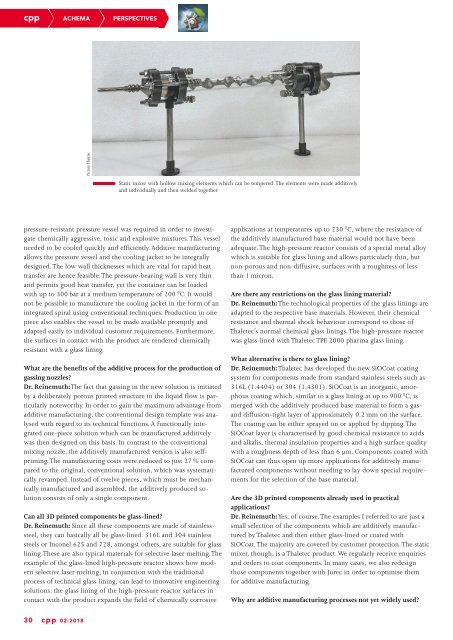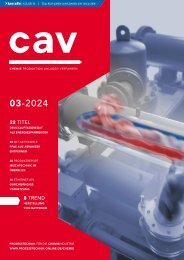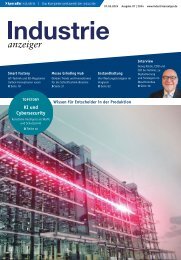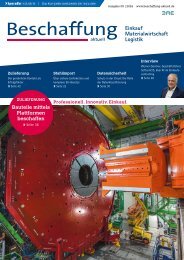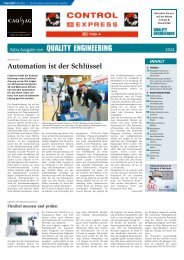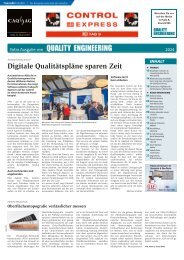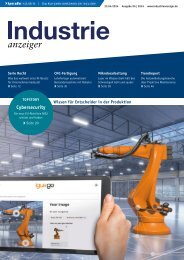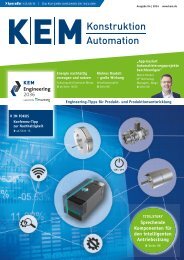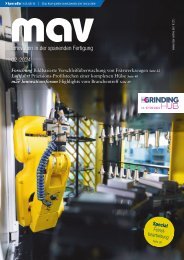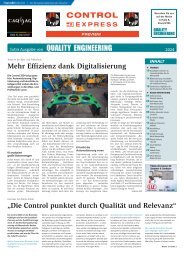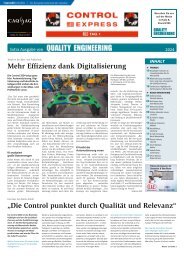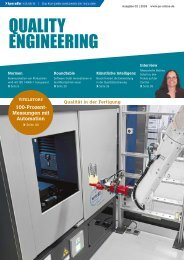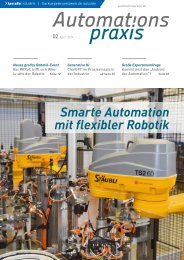cpp - Process technology for the chemical industry 02.2018
You also want an ePaper? Increase the reach of your titles
YUMPU automatically turns print PDFs into web optimized ePapers that Google loves.
<strong>cpp</strong> ACHEMA PERSPECTIVES<br />
Picture: Thaletec<br />
Static mixer with hollow mixing elements which can be tempered. The elements were made additively<br />
and individually and <strong>the</strong>n welded toge<strong>the</strong>r<br />
pressure-resistant pressure vessel was required in order to investi -<br />
gate <strong>chemical</strong>ly aggressive, toxic and explosive mixtures. This vessel<br />
needed to be cooled quickly and efficiently. Additive manufacturing<br />
allows <strong>the</strong> pressure vessel and <strong>the</strong> cooling jacket to be integrally<br />
designed. The low wall thicknesses which are vital <strong>for</strong> rapid heat<br />
transfer are hence feasible. The pressure-bearing wall is very thin<br />
and permits good heat transfer, yet <strong>the</strong> container can be loaded<br />
with up to 300 bar at a medium temperature of 200 °C. It would<br />
not be possible to manufacture <strong>the</strong> cooling jacket in <strong>the</strong> <strong>for</strong>m of an<br />
integrated spiral using conventional techniques. Production in one<br />
piece also enables <strong>the</strong> vessel to be made available promptly and<br />
adapted easily to individual customer requirements. Fur<strong>the</strong>rmore,<br />
<strong>the</strong> surfaces in contact with <strong>the</strong> product are rendered <strong>chemical</strong>ly<br />
resistant with a glass lining.<br />
What are <strong>the</strong> benefits of <strong>the</strong> additive process <strong>for</strong> <strong>the</strong> production of<br />
gassing nozzles?<br />
Dr. Reinemuth: The fact that gassing in <strong>the</strong> new solution is initiated<br />
by a deliberately porous printed structure in <strong>the</strong> liquid flow is particularly<br />
noteworthy. In order to gain <strong>the</strong> maximum advantage from<br />
additive manufacturing, <strong>the</strong> conventional design template was analysed<br />
with regard to its technical functions. A functionally integrated<br />
one-piece solution which can be manufactured additively<br />
was <strong>the</strong>n designed on this basis. In contrast to <strong>the</strong> conventional<br />
mixing nozzle, <strong>the</strong> additively manufactured version is also selfpriming.<br />
The manufacturing costs were reduced to just 27 % compared<br />
to <strong>the</strong> original, conventional solution, which was systematically<br />
revamped. Instead of twelve pieces, which must be mechanically<br />
manufactured and assembled, <strong>the</strong> additively produced so -<br />
lution consists of only a single component.<br />
Can all 3D printed components be glass-lined?<br />
Dr. Reinemuth: Since all <strong>the</strong>se components are made of stainless<br />
steel, <strong>the</strong>y can basically all be glass-lined. 316L and 304 stainless<br />
steels or Inconel 625 and 728, amongst o<strong>the</strong>rs, are suitable <strong>for</strong> glass<br />
lining. These are also typical materials <strong>for</strong> selective laser melting. The<br />
example of <strong>the</strong> glass-lined high-pressure reactor shows how mod -<br />
ern selective laser melting, in conjunction with <strong>the</strong> traditional<br />
process of technical glass lining, can lead to innovative engineering<br />
solutions: <strong>the</strong> glass lining of <strong>the</strong> high-pressure reactor surfaces in<br />
contact with <strong>the</strong> product expands <strong>the</strong> field of <strong>chemical</strong>ly corrosive<br />
applications at temperatures up to 230 °C, where <strong>the</strong> resistance of<br />
<strong>the</strong> additively manufactured base material would not have been<br />
adequate. The high-pressure reactor consists of a special metal alloy<br />
which is suitable <strong>for</strong> glass lining and allows particularly thin, but<br />
non-porous and non-diffusive, surfaces with a roughness of less<br />
than 1 micron.<br />
Are <strong>the</strong>re any restrictions on <strong>the</strong> glass lining material?<br />
Dr. Reinemuth: The technological properties of <strong>the</strong> glass linings are<br />
adapted to <strong>the</strong> respective base materials. However, <strong>the</strong>ir <strong>chemical</strong><br />
resistance and <strong>the</strong>rmal shock behaviour correspond to those of<br />
Thaletec’s normal <strong>chemical</strong> glass linings. The high-pressure reactor<br />
was glass-lined with Thaletec TPE 2000 pharma glass lining.<br />
What alternative is <strong>the</strong>re to glass lining?<br />
Dr. Reinemuth: Thaletec has developed <strong>the</strong> new SiOCoat coating<br />
system <strong>for</strong> components made from standard stainless steels such as<br />
316L (1.4404) or 304 (1.4301). SiOCoat is an inorganic, amorphous<br />
coating which, similar to a glass lining at up to 900 °C, is<br />
merged with <strong>the</strong> additively produced base material to <strong>for</strong>m a gasand<br />
diffusion-tight layer of approximately 0.2 mm on <strong>the</strong> surface.<br />
The coating can be ei<strong>the</strong>r sprayed on or applied by dipping. The<br />
SiOCoat layer is characterised by good <strong>chemical</strong> resistance to acids<br />
and alkalis, <strong>the</strong>rmal insulation properties and a high surface quality<br />
with a roughness depth of less than 6 μm. Components coated with<br />
SiOCoat can thus open up more applications <strong>for</strong> additively manufactured<br />
components without needing to lay down special requirements<br />
<strong>for</strong> <strong>the</strong> selection of <strong>the</strong> base material.<br />
Are <strong>the</strong> 3D printed components already used in practical<br />
applications?<br />
Dr. Reinemuth: Yes, of course. The examples I referred to are just a<br />
small selection of <strong>the</strong> components which are additively manufac -<br />
tured by Thaletec and <strong>the</strong>n ei<strong>the</strong>r glass-lined or coated with<br />
SiOCoat. The majority are covered by customer protection. The static<br />
mixer, though, is a Thaletec product. We regularly receive enquiries<br />
and orders to coat components. In many cases, we also redesign<br />
those components toge<strong>the</strong>r with Jurec in order to optimise <strong>the</strong>m<br />
<strong>for</strong> additive manufacturing.<br />
Why are additive manufacturing processes not yet widely used?<br />
30 <strong>cpp</strong> 02-2018


